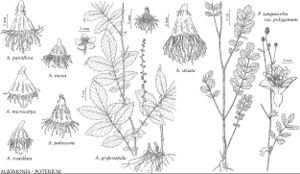Difference between revisions of "Poterium sanguisorba var. polygamum"
Fl. Dalmat. 3: 255. 1851.
FNA>Volume Importer |
FNA>Volume Importer |
||
| Line 10: | Line 10: | ||
|special_status={{Treatment/ID/Special_status | |special_status={{Treatment/ID/Special_status | ||
|code=F | |code=F | ||
| − | |label= | + | |label=Illustrated |
}}{{Treatment/ID/Special_status | }}{{Treatment/ID/Special_status | ||
|code=I | |code=I | ||
| Line 18: | Line 18: | ||
|name=Poterium polygamum | |name=Poterium polygamum | ||
|authority=Waldstein & Kitaibel | |authority=Waldstein & Kitaibel | ||
| + | |rank=species | ||
|publication_title=Descr. Icon. Pl. Hung. | |publication_title=Descr. Icon. Pl. Hung. | ||
|publication_place=2: 217, plate 198. 1805 | |publication_place=2: 217, plate 198. 1805 | ||
| Line 24: | Line 25: | ||
|name=P. balearicum | |name=P. balearicum | ||
|authority=(Nyman) Bourgeau ex Porta | |authority=(Nyman) Bourgeau ex Porta | ||
| + | |rank=species | ||
}} {{Treatment/ID/Synonym | }} {{Treatment/ID/Synonym | ||
|name=P. sanguisorba subsp. muricatum | |name=P. sanguisorba subsp. muricatum | ||
|authority=Bonnier & Layens | |authority=Bonnier & Layens | ||
| + | |rank=subspecies | ||
}} {{Treatment/ID/Synonym | }} {{Treatment/ID/Synonym | ||
|name=Sanguisorba minor subsp. balearica | |name=Sanguisorba minor subsp. balearica | ||
|authority=(Nyman) Muñoz Garmendia & C. Navarro | |authority=(Nyman) Muñoz Garmendia & C. Navarro | ||
| + | |rank=subspecies | ||
}} {{Treatment/ID/Synonym | }} {{Treatment/ID/Synonym | ||
|name=S. minor subsp. muricata | |name=S. minor subsp. muricata | ||
|authority=(Bonnier & Layens) Briquet | |authority=(Bonnier & Layens) Briquet | ||
| + | |rank=subspecies | ||
}} | }} | ||
|hierarchy=Rosaceae;Rosaceae subfam. Rosoideae;Rosaceae tribe Agrimonieae;Poterium;Poterium sanguisorba;Poterium sanguisorba var. polygamum | |hierarchy=Rosaceae;Rosaceae subfam. Rosoideae;Rosaceae tribe Agrimonieae;Poterium;Poterium sanguisorba;Poterium sanguisorba var. polygamum | ||
| Line 48: | Line 53: | ||
|elevation=0–2700 m | |elevation=0–2700 m | ||
|distribution=B.C.;N.S.;Ont.;Que.;Ala.;Ariz.;Calif.;Colo.;Conn.;Del.;Idaho;Ill.;Ind.;Md.;Mass.;Mich.;Mont.;Nev.;N.J.;N.Mex.;N.Y.;N.C.;Ohio;Oreg.;Pa.;R.I.;Tenn.;Tex.;Utah;Vt.;Va.;Wash.;W.Va.;Wyo.;Europe;w Asia;n Africa;introduced also in Australia. | |distribution=B.C.;N.S.;Ont.;Que.;Ala.;Ariz.;Calif.;Colo.;Conn.;Del.;Idaho;Ill.;Ind.;Md.;Mass.;Mich.;Mont.;Nev.;N.J.;N.Mex.;N.Y.;N.C.;Ohio;Oreg.;Pa.;R.I.;Tenn.;Tex.;Utah;Vt.;Va.;Wash.;W.Va.;Wyo.;Europe;w Asia;n Africa;introduced also in Australia. | ||
| − | |discussion=<p>All North American plants of <i>Poterium</i> belong to < | + | |discussion=<p>All North American plants of <i>Poterium</i> belong to <i></i>var.<i> polygamum</i>. This taxon has also been reported for New Brunswick; this is unconfirmed, but certainly plausible. Reports for North America of <i>Sanguisorba</i> minor or <i>P. sanguisorba</i> refer to that in a broad sense, not distinguishing the varieties or subspecies variously recognized, and do not imply the occurrence of the typical infrataxon in North America. It is possible that the typical variety (or other infrataxa, as defined in the European literature) is present in North America. The other infrataxa differ primarily in details of the ornamentation of the hypanthium, with either more or less pronounced wings, differences in the roundedness or acuteness of the wings, and variations in the reticulate patterns between the wings; refer to the European literature to identify material suspected of belonging to other infrataxa.</p> |
|tables= | |tables= | ||
|references= | |references= | ||
| Line 57: | Line 62: | ||
-->{{#Taxon: | -->{{#Taxon: | ||
name=Poterium sanguisorba var. polygamum | name=Poterium sanguisorba var. polygamum | ||
| − | |||
|authority=(Waldstein & Kitaibel) Visiani | |authority=(Waldstein & Kitaibel) Visiani | ||
|rank=variety | |rank=variety | ||
| Line 72: | Line 76: | ||
|publication title=Fl. Dalmat. | |publication title=Fl. Dalmat. | ||
|publication year=1851 | |publication year=1851 | ||
| − | |special status= | + | |special status=Illustrated;Introduced |
| − | |source xml=https://jpend@bitbucket.org/aafc-mbb/fna-data-curation.git/src/ | + | |source xml=https://jpend@bitbucket.org/aafc-mbb/fna-data-curation.git/src/f50eec43f223ca0e34566be0b046453a0960e173/coarse_grained_fna_xml/V9/V9_519.xml |
|subfamily=Rosaceae subfam. Rosoideae | |subfamily=Rosaceae subfam. Rosoideae | ||
|tribe=Rosaceae tribe Agrimonieae | |tribe=Rosaceae tribe Agrimonieae | ||
Revision as of 23:41, 16 December 2019
Leaves: stipules of basal leaves simple, lanceolate, margins entire, those of cauline lanceolate to ovate, coarsely serrate; petiole longer than blade in basal and proximal cauline leaves, to shorter than proximal rachis segment in distal cauline ones; leaflets 2–12 pairs, proximally alternate, subopposite, or opposite, distally subopposite or opposite, margins coarsely serrate, surfaces glabrous or sparsely pilose. Spikes subglobose to ovoid, 0.3–2.5 × 0.3–2 cm; peduncles glabrous or sparsely loosely villous; bracteoles ovate, equal to hypanthia, ciliate. Flowers generally gynomonoecious, bisexual flowers proximal and pistillate distal (rarely some spikes completely pistillate or completely bisexual); hypanthium broadly ellipsoid; sepals green to purple, margins scarious, apex acute to apiculate with tufts of trichomes; filaments filiform, equal to sepals. Achenes enclosed within broadly ellipsoid hypanthia 4 mm, 4-sided, angles winged, surfaces irregularly reticulately ridged, ridges sometimes also muricate. 2n = 28, 56.
Phenology: Flowering May–Aug; fruiting Jul–Oct.
Habitat: Open disturbed areas, pastures, roadsides, woodland edges, along railroad rights-of-way, some preference for calcareous soil
Elevation: 0–2700 m
Distribution

B.C., N.S., Ont., Que., Ala., Ariz., Calif., Colo., Conn., Del., Idaho, Ill., Ind., Md., Mass., Mich., Mont., Nev., N.J., N.Mex., N.Y., N.C., Ohio, Oreg., Pa., R.I., Tenn., Tex., Utah, Vt., Va., Wash., W.Va., Wyo., Europe, w Asia, n Africa, introduced also in Australia.
Discussion
All North American plants of Poterium belong to var. polygamum. This taxon has also been reported for New Brunswick; this is unconfirmed, but certainly plausible. Reports for North America of Sanguisorba minor or P. sanguisorba refer to that in a broad sense, not distinguishing the varieties or subspecies variously recognized, and do not imply the occurrence of the typical infrataxon in North America. It is possible that the typical variety (or other infrataxa, as defined in the European literature) is present in North America. The other infrataxa differ primarily in details of the ornamentation of the hypanthium, with either more or less pronounced wings, differences in the roundedness or acuteness of the wings, and variations in the reticulate patterns between the wings; refer to the European literature to identify material suspected of belonging to other infrataxa.
Selected References
None.
